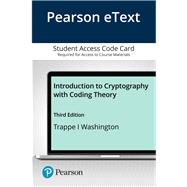A broad spectrum of cryptography topics, covered from a mathematical point of view.
Extensively revised and updated, the 3rd Edition of Introduction to Cryptography with Coding Theory mixes applied and theoretical aspects to build a solid foundation in cryptography and security. The authors' lively, conversational tone and practical focus inform a broad coverage of topics from a mathematical point of view, and reflect the most recent trends in the rapidly changing field of cryptography.
For courses in Cryptography, Network Security, and Computer Security.
Pearson eText is an easy-to-use digital textbook that you can purchase on your own or instructors can assign for their course. The mobile app lets you keep on learning, no matter where your day takes you -- even offline. You can also add highlights, bookmarks, and notes in your Pearson eText to study how you like.
NOTE: This ISBN is for the Pearson eText access card. Pearson eText is a fully digital delivery of Pearson content. Before purchasing, check that you have the correct ISBN. To register for and use Pearson eText, you may also need a course invite link, which your instructor will provide. Follow the instructions provided on the access card to learn more.










